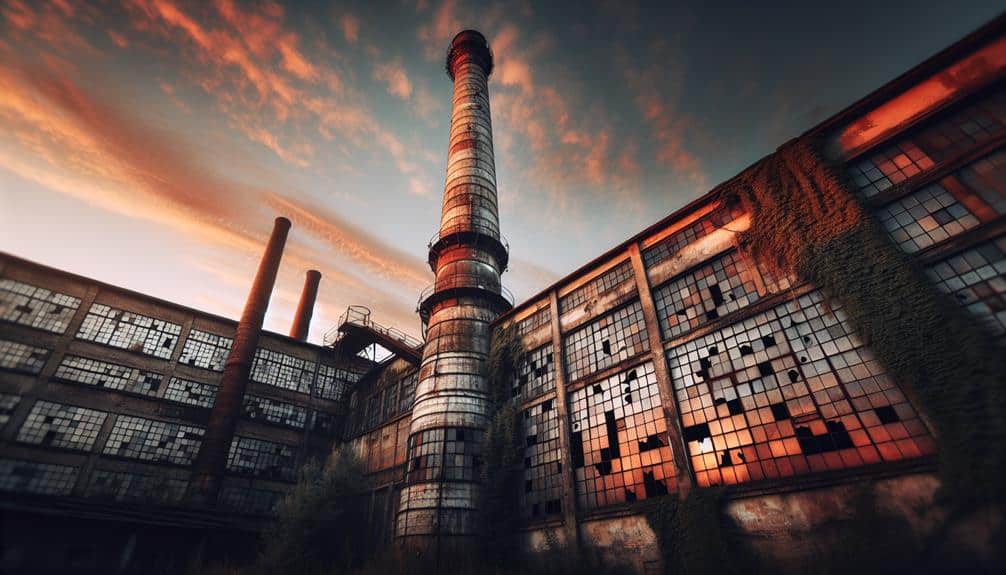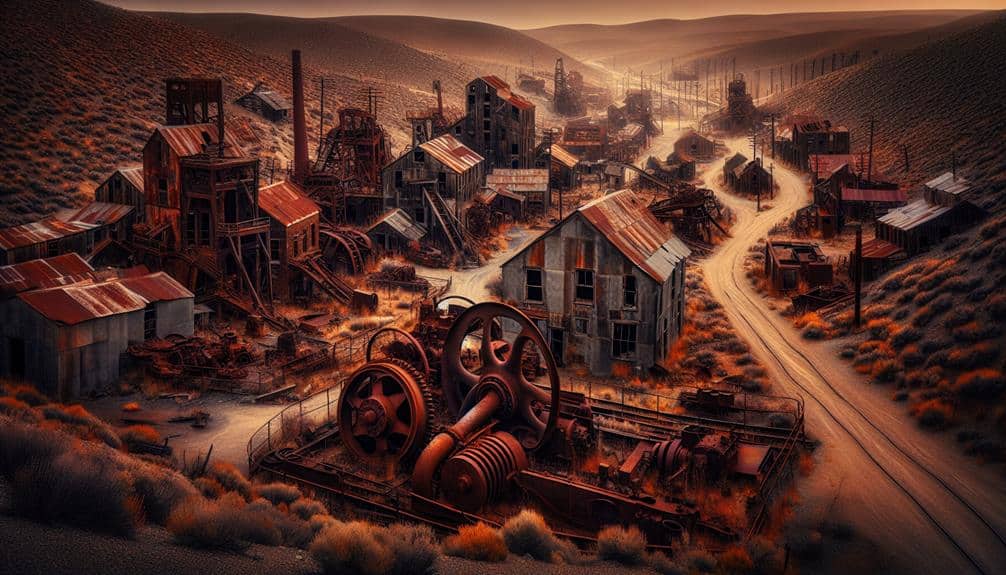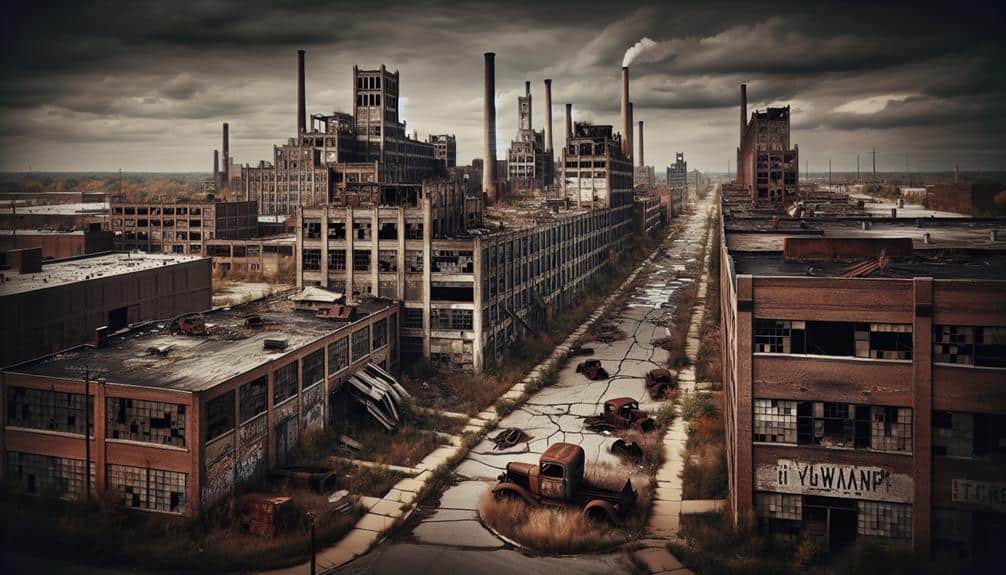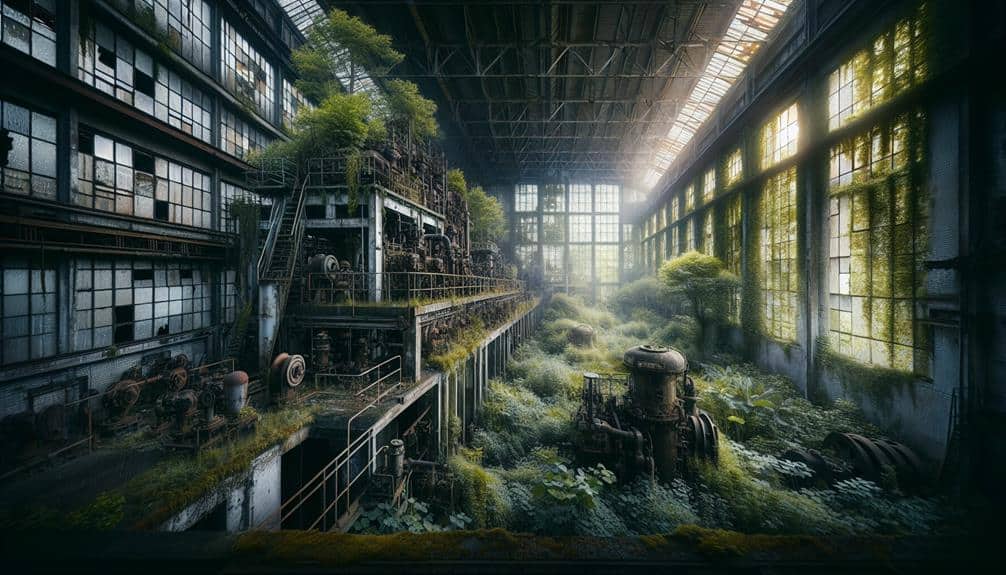Explore eerie industrial remnants in the US like Silver City, Idaho's preserved ghost town from the silver mining boom. Witness Centralia, Pennsylvania's burning coal mine that condemned the town due to toxic gases. Kennecott, Alaska's abandoned copper mine showcases eerie decay and toxic legacy. Bodie, California's frozen gold-mining town echoes past lives among weathered buildings. Thurmond, West Virginia stands desolate, a reminder of coal heritage overshadowed by industrial shifts. Discover Rhyolite, Nevada's skeletal remains and iconic Bottle House reflecting former glory. Cahawba, Alabama's history whispers through overgrown streets and riverside ruins. These remnants hold secrets of past industrial prosperity.
Key Points
- Silver City, Idaho: Preserved silver mining ghost town since 1863.
- Centralia, Pennsylvania: Ongoing coal mine fire, town condemned in 1992.
- Kennecott, Alaska: Abandoned copper mine with toxic legacy in wilderness.
- Bodie, California: Frozen gold-mining town with weathered buildings.
- Thurmond, West Virginia: Eerie Appalachian ghost town with coal heritage.
Silver City, Idaho
Silver City, Idaho, stands as a well-preserved ghost town in the US, offering a glimpse into the industrial boomtown era of the late 19th century. Its mining history is deeply rooted in the silver mining industry, which drove the town's rapid growth and eventual decline. The discovery of silver in the area attracted a wave of fortune seekers, leading to the establishment of Silver City in 1863.
The town quickly flourished, boasting a population of over 2,500 residents at its peak. Silver City became a hub of activity, with numerous mines operating in the surrounding hills. The silver mining industry fueled economic prosperity, attracting businesses, saloons, and theaters to cater to the growing population.
However, as the silver veins depleted and the industry faced challenges, Silver City's fortunes began to wane. By the early 20th century, the town's population dwindled, leaving behind empty buildings and remnants of its once-thriving past. Today, visitors can explore the abandoned streets and buildings, gaining insight into the rise and fall of this historic mining town.
Centralia, Pennsylvania
In contrast to the silver mining history of Silver City, Idaho, Centralia, Pennsylvania, presents a haunting tale of industrial remnants and a town forever changed by underground coal fires. Centralia's story began in 1962 when a coal mine fire was intentionally set to clean up a landfill. However, the fire spread through unsealed tunnels, igniting a blaze that continues to burn underground to this day, releasing toxic gases and causing sinkholes to form across the town.
The underground fire forced residents to evacuate, and the government condemned the town in 1992, relocating most of its buildings. Only a few residents remain today, holding out against government orders. Centralia's streets are cracked, and smoke rises from the ground, a constant reminder of the devastation caused by the coal mine fire. Despite efforts to extinguish it, the fire is expected to burn for centuries, leaving Centralia as a chilling reminder of the dangers of industrial negligence and the irreversible consequences of underground fires.
Kennecott, Alaska
When you explore Kennecott, Alaska, you'll encounter an abandoned copper mine that once thrived in this remote Alaskan wilderness.
The historic ghost town stands as a proof to the bustling industrial activity that once dominated the area.
The preserved buildings and artifacts offer a glimpse into the past, attracting visitors seeking a unique historical experience.
Abandoned Copper Mine
Nestled in the remote wilderness of Alaska, the abandoned copper mine at Kennecott stands as a haunting evidence to the industrial boomtown that once thrived in this rugged landscape.
The industrial decay is palpable, with rusting machinery and crumbling structures scattered across the site, painting a picture of a once-bustling mining operation now frozen in time.
The toxic legacy left behind by the mining activities adds a layer of complexity to the eerie atmosphere, as the environmental impact of such operations becomes starkly evident.
Despite the desolation, there's a sense of raw beauty in the stark contrast between the man-made structures and the untamed wilderness that surrounds them, offering a poignant reminder of the delicate balance between human progress and nature's resilience.
Historic Ghost Town
The historic ghost town of Kennecott, Alaska, stands as a poignant confirmation to a bygone era of industrial prosperity and subsequent abandonment. Once a bustling mining town, Kennecott now epitomizes urban decay with its deserted buildings and rusting machinery.
The remnants of this once-thriving community serve as a stark reminder of the transient nature of industrial boomtowns. Walking through the empty streets, you can almost feel the echoes of the past, envisioning the miners and their families who once called this place home. The deteriorating structures tell a silent tale of the rise and fall of the mining industry in this remote Alaskan wilderness.
As you explore Kennecott, you can't help but be captivated by the haunting beauty and melancholic charm of this historic ghost town.
Remote Alaskan Wilderness
Surrounded by rugged mountains and vast glaciers, Kennecott, Alaska, lies nestled deep within the remote Alaskan wilderness, offering a glimpse into a once vibrant mining community now frozen in time.
This area beckons to those seeking wilderness exploration and the challenge of testing their survival skills amidst untamed nature. Remote homesteading and off-grid living are essential here, where modern amenities are scarce, and self-sufficiency is paramount.
The harsh yet breathtaking landscape of Kennecott, Alaska, provides a unique backdrop for those looking to disconnect from the chaos of urban life and reconnect with the raw beauty of the Alaskan wilderness.
As you navigate this remote expanse, the remnants of a bygone era serve as a reminder of the resilience and adaptability required to thrive in such unforgiving terrain.
Bodie, California
Amidst the vast expanse of California's landscape lies Bodie, a well-preserved ghost town that offers a glimpse into the industrial boomtown era of the United States.
- Bodie, once a bustling gold-mining town, now stands frozen in time, showcasing the remnants of the California gold rush.
- The town's preserved history is evident in its weathered buildings, some of which still contain furniture and belongings from the late 1800s.
- Walking down Bodie's dusty streets, you can almost hear the echoes of the past, imagining the lives of the miners, shopkeepers, and families who once called this place home.
- Peering through the windows of the abandoned schoolhouse or the former saloon, you get a sense of the community that thrived here during its heyday.
- The backdrop of the Sierra Nevada mountains adds a touch of wild beauty to this ghost town, reminding you of the rugged landscape that drew people to seek their fortunes in this remote corner of California.
Thurmond, West Virginia
Thurmond, West Virginia, stands as a testament to ghost town history in the heart of Appalachia. The abandoned railroad tracks that once bustled with coal trains now whisper tales of a forgotten coal heritage.
Explore the remnants of this once-thriving industrial boomtown and uncover the echoes of its past.
Ghost Town History
Nestled in the Appalachian Mountains of West Virginia lies the ghost town of Thurmond, a historic remnant of America's industrial boomtown era. Thurmond, once a bustling railroad town, now stands frozen in time, offering a glimpse into the past. Explore the ghostly streets where history whispers through the abandoned buildings and railroad tracks.
- Thurmond's population peaked at around 500 residents during its heyday.
- The town's decline began with the shift from coal to diesel locomotives.
- Thurmond's railway depot is one of the last original structures left.
- The town is known for its eerie quietness and desolate atmosphere.
- Thurmond has been featured in films due to its haunting ambiance and untouched feel.
Abandoned Railroad Tracks
Thurmond's abandoned railroad tracks weave a silent narrative of the town's crucial industrial past, now standing as eerie relics of a bygone era in West Virginia's Appalachian Mountains.
These rusty tracks, once essential arteries of transportation for coal and goods, now lie dormant, overgrown by nature reclaiming its territory.
The abandoned stations along the line stand as haunting reminders of the bustling activity that once echoed through these valleys.
As you walk along the tracks, the creaking of old metal and the distant echoes of a train whistle long gone evoke a sense of nostalgia for a time long past.
The stillness of the abandoned stations and the desolate landscape around them whisper tales of a vibrant industrial history now lost to time.
Forgotten Coal Heritage
What significant role did the coal heritage play in shaping the industrial landscape of West Virginia's Thurmond? The coal mining legacy in Thurmond, West Virginia, has left a lasting impact on the town's industrial development, contributing to both its rise and eventual decline. The remnants of this forgotten coal heritage can still be seen today, telling a story of industrial decay and a once-thriving community now frozen in time.
- Abandoned coal mines dotting the landscape.
- Rusting coal carts scattered along the train tracks.
- Dilapidated mining equipment left to rust in the open.
- Empty company housing standing as a reminder of past prosperity.
- Crumbling coal processing facilities overtaken by nature.
Rhyolite, Nevada
Located in Nevada, the ghost town of Rhyolite offers a glimpse into its industrial past. Established in 1905, Rhyolite thrived on significant gold discoveries, evident in its skeletal remains like the three-story bank, the jail, and the train depot. The ruins of the old school whisper stories of the town's former glory, where children of miners once learned. Among the deserted desert landscapes, the iconic Bottle House made of discarded bottles stands out as a unique sight. Rhyolite, frozen in time, serves as a poignant reminder of the transient nature of industrial prosperity, waiting for visitors to explore and appreciate.
The lost western town of Rhyolite stands as a testament to the once bustling mining industry in the region. Walking through its deserted desert landscapes, visitors can witness the skeletal remains of various structures like the three-story bank, the jail, and the train depot, hinting at the town's former glory. The ruins of the old school add to the historical narrative, preserving the legacy of the children of miners who once walked its halls. One of the most striking sights in Rhyolite is the iconic Bottle House, constructed from discarded bottles, offering a unique contrast against the backdrop of the Nevada desert. Frozen in time, Rhyolite invites contemplation and reflection on the transient nature of industrial prosperity.
Cahawba, Alabama
In Alabama, Cahawba stands as a haunting reminder of a once-thriving southern town, now abandoned and left to the elements. The historic ruins of Cahawba offer a glimpse into a bygone era, particularly the Civil War period. Here are some key features that paint a vivid picture of this ghost town:
- Overgrown streets: Nature has reclaimed the streets of Cahawba, with vegetation weaving through the cracked pavement.
- Collapsed buildings: Many buildings in Cahawba lie in ruins, their walls crumbling and roofs caved in.
- Abandoned cemetery: The cemetery in Cahawba serves as a solemn reminder of the town's former residents, with weathered tombstones dotting the landscape.
- River views: The town's location along the Cahaba River provides scenic views, adding to the eerie charm of the deserted area.
- Historic landmarks: Civil War era landmarks like the St. Luke's Episcopal Church ruins stand as evidence to Cahawba's rich history, now frozen in time.
Explore Cahawba to witness a poignant blend of historic ruins and Civil War era landmarks, encapsulating the essence of a town lost to time.
Frequently Asked Questions
What Caused the Decline of These Industrial Boomtowns?
The decline of industrial boomtowns in the US was caused by a combination of environmental impact and economic shifts. Pollution, resource depletion, and changing market demands led to their downfall, leaving behind haunting remnants of a bygone era.
Are There Any Haunted Legends or Ghost Stories Associated With These Remnants?
You can uncover chilling tales of paranormal investigations and supernatural encounters intertwined with local folklore while engaging in urban exploration. These haunting legends add an eerie layer of mystery to the remnants of industrial boomtowns.
How Accessible Are These Sites to the Public for Exploration?
You can access these sites for exploration, but caution is advised due to safety risks. Many offer guided tours or have limited public access. Check local regulations and tour availability for opportunities to explore.
Have Any Efforts Been Made to Preserve or Restore Any of the Historic Buildings in These Towns?
Preservation efforts have been ongoing in several towns, aiming to restore historic buildings. Restoration projects breathe life into forgotten structures, honoring the past. The adage "Out with the old, in with the new" reflects the delicate balance of progress and preservation.
Are There Any Unique Events or Festivals Held in These Locations to Celebrate Their History?
You'll find a variety of community events celebrating heritage in these locations. Unique festivals often showcase the rich history of these towns, offering visitors a glimpse into the past through engaging and interactive experiences.



